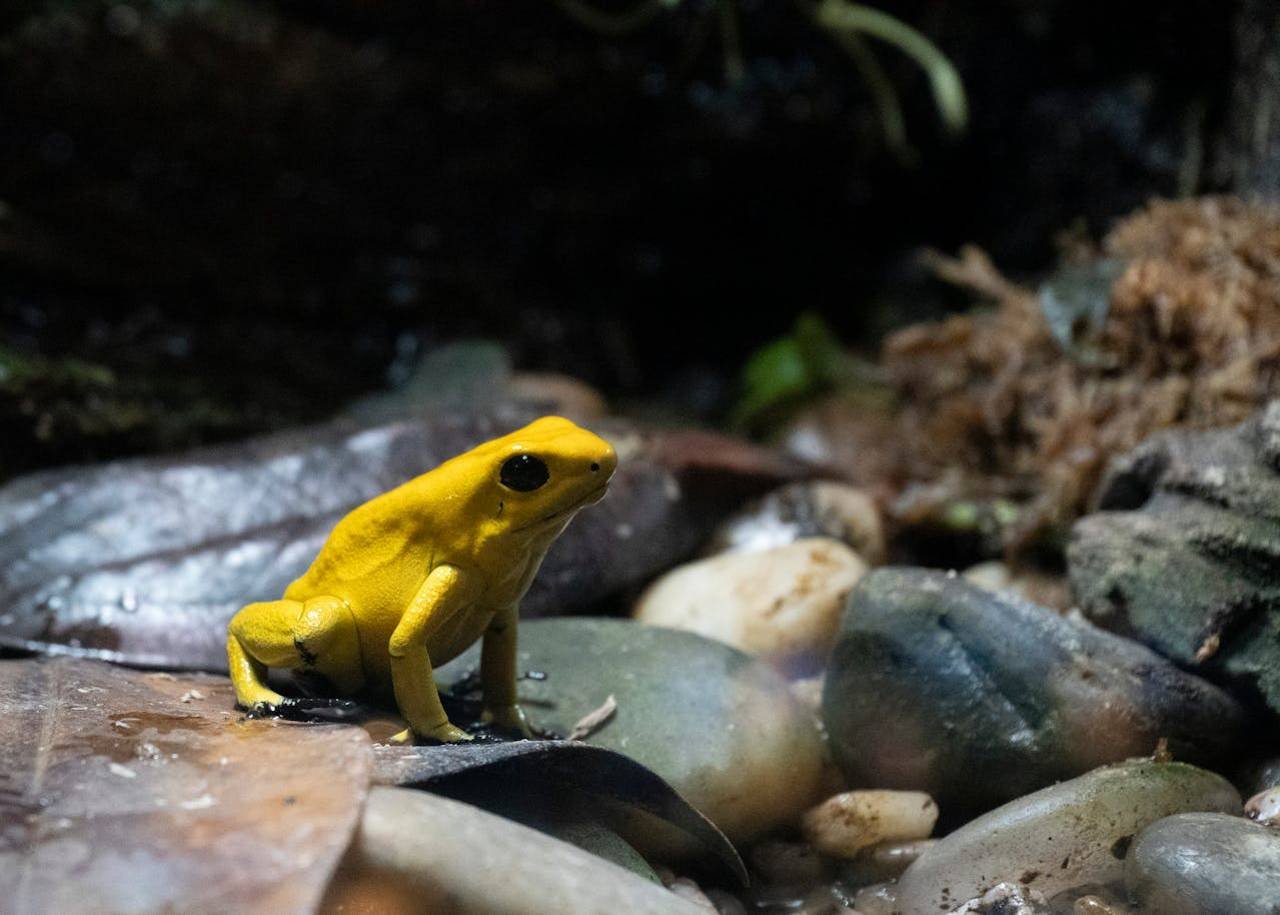The Golden Poison Frog, scientifically known as Phyllobates terribilis, is one of the most toxic creatures known to man. Native to the rainforests of Colombia, this vibrant amphibian stands out not only for its striking appearance but also its potent defense mechanism. Let’s delve into the fascinating world of the Golden Poison Frog and understand what makes it a standout species in the realm of amphibians.
Characteristics and Appearance
The Golden Poison Frog is renowned for its bright yellow-orange coloration, a stark warning to potential predators about its lethal nature. This aposematic coloring is a common feature among toxic species and is a prime example of nature’s way of signaling danger. Adult Golden Poison Frogs typically measure around 1.5 to 2 inches in length, and their vivid colors range from yellow to shades of green.
Habitat and Distribution
These frogs are found exclusively in the rainforests along the Pacific coast of Colombia. They thrive in humid, tropical environments with a diet rich in diverse insects that contribute to their toxicity. These forests provide the perfect combination of moisture and temperature that these amphibians need to survive.
Toxicity and Diet
The Golden Poison Frog is famed for its extreme toxicity, with alkaloid batrachotoxins in its skin that can be lethal to any predator. It’s estimated that a single frog carries enough toxin to kill 10 to 20 adult humans or 10,000 mice. However, these frogs don’t produce the toxin themselves; instead, they derive it from their diet in the wild, which includes specific species of ants, mites, and other small invertebrates.
Conservation Status
Currently, the Golden Poison Frog is classified as endangered due to habitat loss and environmental changes. The destruction of Colombian rainforests for agriculture and logging poses a significant threat to their natural habitat. Conservation efforts are crucial to preserve these ecosystems, emphasizing habitat protection and the study of these frogs in captivity to understand their needs better.
Reproduction and Breeding
Golden Poison Frogs have unique breeding habits. During the rainy season, males establish territories and call to attract females with a series of trills. Once a mate is found, the female lays a clutch of eggs in a damp environment, such as the leaf litter. The male safeguards the eggs by keeping them moist and, once they hatch, transports the tadpoles on his back to nearby water sources for further development.
These frogs typically breed once per year, with the reproductive cycle closely tied to environmental conditions that ensure successful egg to tadpole development.
Related Topics and Entertaining Reads
To explore more about other intriguing poison dart frog species, check out our comprehensive article on poisonous dart frogs. For more light-hearted content, enjoy our collection of frog jokes and magical frog-themed fairy tales for entertainment beyond the realm of science.
FAQs About Golden Poison Frogs
What makes the Golden Poison Frog so toxic?
The Golden Poison Frog contains batrachotoxins in its skin, potent enough to be lethal to large predators and humans. These toxins are acquired from their diet of specific insects.
Are Golden Poison Frogs dangerous to humans?
Yes, they are highly toxic. Handling should only be done by professionals, as their skin secretes potent toxins that can be harmful upon contact.
What conservation efforts exist for Golden Poison Frogs?
Conservation initiatives focus on preserving their habitat, combating deforestation, and supporting captive breeding programs to protect their populations.
Do Golden Poison Frogs live long lives?
In captivity, these frogs can live up to 15 years with proper care, though lifespan in the wild may vary due to environmental pressures and predation.
Can Golden Poison Frogs lose their toxicity in captivity?
Yes, without a diet rich in specific alkaloid insects, they typically lose their toxicity when raised in controlled environments.
How do Golden Poison Frogs acquire their toxins?
Golden Poison Frogs acquire their toxins from their diet of specific alkaloid-rich insects, such as ants and mites, found in their natural rainforest habitat.
Are there any natural predators of the Golden Poison Frog?
Due to their extreme toxicity, the Golden Poison Frog has very few natural predators. Some snakes, such as the fire-bellied snake, may have a resistance to the toxins and can prey on these frogs.
Is there any way to neutralize the toxins of a Golden Poison Frog?
There is no known antidote to neutralize the toxins of a Golden Poison Frog once they’ve entered the system, which is why extreme caution is advised when handling them.
How does the environment influence the Golden Poison Frog’s breeding habits?
The breeding habits of Golden Poison Frogs are closely tied to the rainy season, which provides the necessary moisture and environmental conditions for successful reproduction.
Why are Golden Poison Frogs important to study?
Studying these frogs helps researchers understand the ecological roles of toxins, the evolutionary adaptations that support their survival, and their potential medical applications in studying natural compounds.

